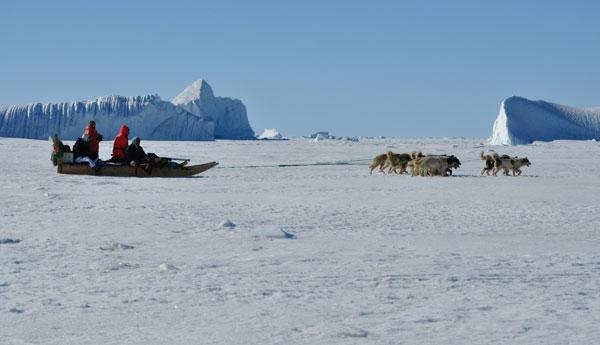Inuit Dog Sleds Help Measure Arctic Sea Ice


Dog sleds that have carried Inuit hunters since the earliest times are now helping tow high technology across the Arctic to investigate the latest global warming-related changes in sea ice there.
Recent measurements have shown that the Arctic has warmed faster than any other region of the world, and satellite images have revealed that the Arctic summer sea ice extent has declined at a rate of over 10 percent per decade.
"In scientific circles, it has been well-recognized that the Arctic is rapidly changing, certainly faster than any other time during recorded history," said sea ice physicist Jeremy Wilkinson at the Scottish Association for Marine Science.
Satellites, while they provide excellent views of the area of Arctic Ocean covered by sea ice, cannot yet scan ice thickness from space. Researchers instead rely on scientific instruments such as those that generate magnetic fields to induce what are called eddy currents in the water beneath sea ice. The devices can measure the strength of these currents, which depends on the distance between the instruments and the bottom of the sea ice, thus revealing how thick the ice is. They typically are installed on the bows of icebreaker ships or hung below helicopters.
During time spent with Inuit hunters during research on the sea ice off Greenland, "we learned of the severe difficulties that the local communities faced because of the climate-driven changes to the sea ice conditions," Wilkinson recalled. "We also saw the large number of dog teams that were on the ice everyday and the vast distances they covered. Then came the light bulb moment why don't we put sensors on these sleds?"
Sled-mounted sensors
These instruments were hard to mount on sleds because they are unwieldy, consisting of 13-foot-long, 2-inch-wide (4 meters long, 5 centimeters wide) pipes with small boxes of electronics in the middle. However, researchers have recently developed half-length versions of the devices that can fit on the sleds of the Inuit, who routinely hunt and travel over large areas of Arctic sea ice in the course of a day, sometimes traveling many thousands of miles a season.
Get the world’s most fascinating discoveries delivered straight to your inbox.
Each instrument was modified to be as autonomous as possible, making them easy to use. For example, each unit has a GPS device to record coordinates, a motion sensor that automatically detects when the sled is moving to activate the system, and solar panels to keep the batteries charged when the sun is out. All this data are stored in the instrument and transmitted over satellite in real time.
"For years, the Inuit have been warning that the sea ice conditions are changing," Wilkinson said. "However, much of their observations are qualitative in nature. These sensors allow them to make accurate and quantitative measurements that can be more readily used by the scientific community."
Field testing in Greenland
These sled-mounted devices were tested in the field last May on the ice on the edges of the coast near Qaanaaq in northwestern Greenland , with two hunters each volunteering a sled. To see how accurate these instruments were, scientists also drilled nearly 150 holes in the ice and compared findings.
The instruments proved accurate, coming within roughly 1 inch (2.8 cm) of drilling results. They also gathered data across almost 125 miles (200 km) in just two days, corresponding to about 20,000 independent ice thickness measurements.
The Inuit hunters gave welcome advice on where and how to mount the instruments and what modifications were needed to withstand rigorous daily use. They were also enthusiastic about helping monitor ice conditions.
"Changes in the thickness, stability and length of the sea ice season will not only influence global climate but will also impact severely on the lives of the Inuit, who rely on the ice not only as their winter highway faster and safer than the sea in summer but also as an important access route for hunting," Wilkinson said.
The researchers seek to further improve the instruments, recording air pressure and adding on better solar panels. The next deployment is set for February to June of 2011.
"The synergy of traditional techniques with cutting-edge technology will enable better information on ice thickness to be obtained in real time," Wilkinson said. "This in turn will lead better and more accurate sea ice charts to be derived and delivered to the local community."





